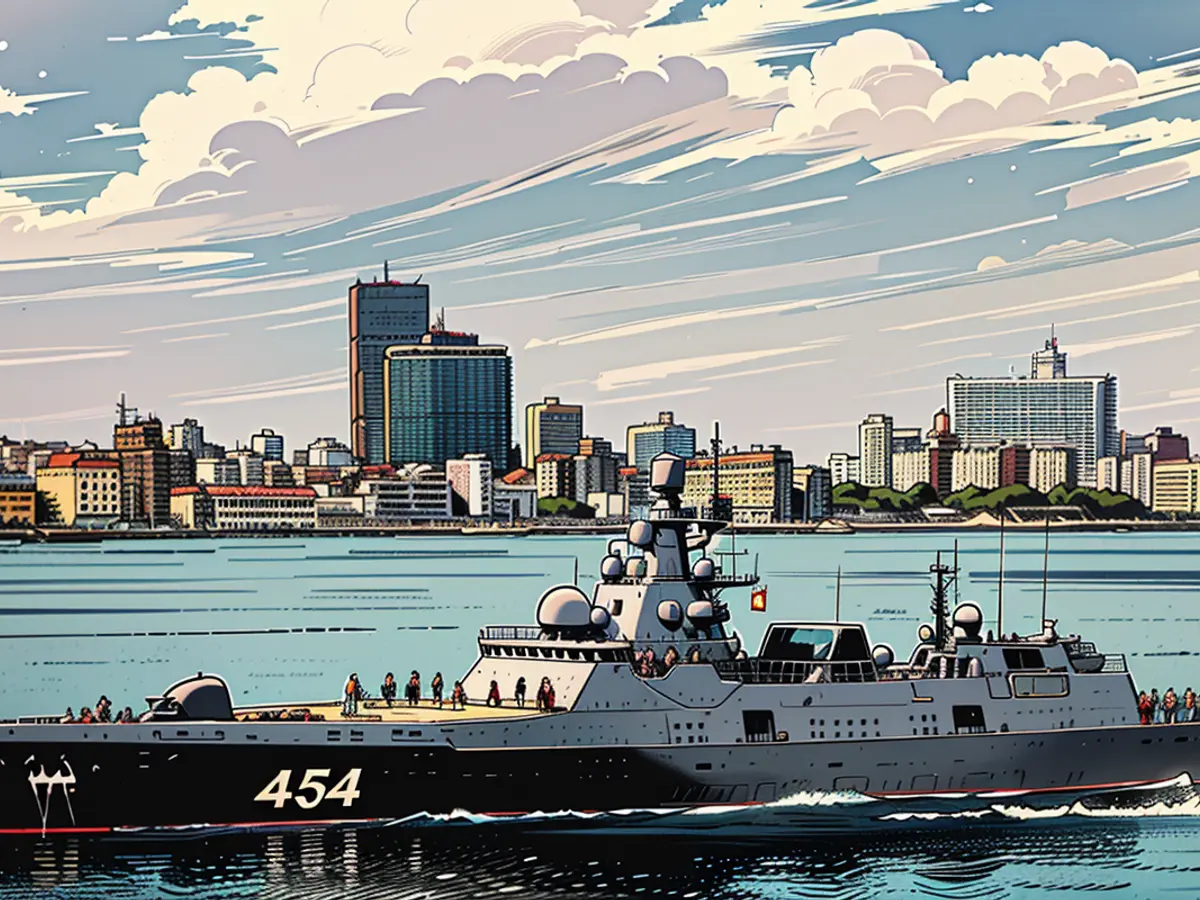Russian Military Vessel Anchored in Cuban Waters
Lines for groceries, lines for bills, lines because people were lined up for something worth waiting for.
But now I was in a queue for something unexpected: to board a Russian warship docked in Havana's harbor.
When a Russian diplomat told me that starting on Thursday, the Admiral Gorshkov frigate would offer tours to the public for three days, I was somewhat doubtful.
The Gorshkov is one of the most advanced vessels in the Russian fleet, capable of launching hypersonic missiles that travel at over 6,000 miles per hour. I found it hard to believe that President Vladimir Putin's prized ship would be open to anyone to see.
When the Gorshkov arrived in Cuba on Wednesday, it fired a deafening 21-gun salute. The Cubans responded with cannon fire from an 18th-century fortress overlooking the harbor that the Spanish had built to protect the city from pirates. Along with the frigate came a rescue tug, a fuel ship, and the Kazan, an immense nuclear-powered submarine.
Cuba's Ministry of Defense stated that none of the ships were carrying nuclear weapons and that they did not pose "a threat to the region," implying the US, Cuba's neighbor 90 miles to the north.
But for many Cubans, the visit of the largest convoy of ships in years from their old Cold War ally seemed like a step back in time, especially as Moscow and Washington continued their disagreements over the war in Ukraine.
"I never thought I would see a Russian submarine so close up," said a Cuban man next to me as we waited in line, staring at the four vessels. We stood outside the port terminal in Havana, which, just a few years earlier, had been filled with US cruise ships, until then-President Donald Trump banned their visits to the island in 2019.
Even though a line had formed, it was unclear if any of us waiting there would actually get aboard. An hour passed beneath the blistering Cuban sun.
"We're roasting out here," a woman carrying a baby next to me complained. Cubans are experts at waiting in line, and I worried that I would have nothing to show for my time outside the port other than a worsening sunburn.
Finally, a Cuban Navy official in a gleaming white uniform came out to speak to us, putting his hand on my shoulder.
"You can board the ship, but you must leave any sharp objects like knives, scissors, or hair clippers behind," he said.
Two plain-clothes state security officers began to run everyone's identification card numbers through a database on their phones.
I handed my carne, or ID card, that lists my birthplace in the US, to one of the officers who looked too young to shave. He looked at my carne and turned to his older colleague for advice.
"Should we let foreign residents on board?" he asked.
The older officer, who was wearing a New York Yankees baseball cap, nodded and then ran my card information through the database.

"You can go ahead," he said.
Inside the port, past officials manning a metal detector, Russian sailors in dark blue uniforms waited to take a group of about 20 of us aboard the Gorshkov.
In front of the ship, the sailors had posted a sign in English that declared the Gorshkov's "main purpose" was "combat operations against enemy surface ships and submarines."
The Russian sailors spoke more English than Spanish, and I occasionally translated to help the other members of our group, who were all Cuban. We were told we could film and everyone immediately took out their smartphones to take videos and selfies.
We started on the ship's enormous helicopter pad and then walked through the ship to the bow. Every few feet, a Russian sailor stood watch.
At the front of the ship, one of the sailors showed me an anti-rocket system to be used in the unlikely event that we came under attack. I asked about the massive cannon, and the sailor replied that it could fire shells a distance of 23 kilometers, or about 15 miles.
A level up, where it appeared there was sensitive communication equipment, a Russian soldier in tactical gear with an assault rifle at his side looked down at us.
Just off the bow, we could see an unobstructed view of the Kazan, the 430-foot-long submarine that stretched out into the harbor.
I noticed one of the Russian sailors taking in the blue skies and calm waters around us.
"Cuba good?" I asked him.
"Cuba good," he laughed in reply and gave me a thumbs-up.
The war in Ukraine has severely degraded the Russian fleet, and once again, the US and Russia found themselves on opposite sides of a bloody conflict. For a Russian sailor, Cuba could be as good as it gets these days.
I disembarked the Russian warship in Havana feeling that the Cold War didn't seem so far in the past, when I saw a notification flash across my phone.
It was an announcement that the Pentagon had just dispatched its own nuclear-powered attack submarine to the other side of the island: the US Navy Base in Guantanamo Bay, Cuba, slightly more than 500 miles away from where the Russian ships were docked.

Read also:
The Admiral Gorshkov frigate, being one of the most advanced vessels in the Russian fleet, has sparked interest among the Americas. Many Cubans saw the visit of the Russian convoy as a reminder of their old Cold War ally, a step back in time given the ongoing disagreements between Moscow and Washington over the war in Ukraine.
Despite the tensions, the tour of the Russian warship attracted a crowd, with a Cuban man expressing his excitement, saying, "I never thought I would see a Russian submarine so close up." The Admiral Gorshkov's arrival in the Americas has indeed stirred curiosity and interest across the continent.







